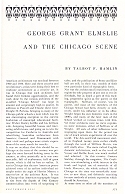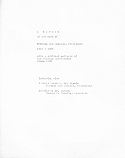|
|
|
Purcell and Elmslie, Architects Firm active :: 1907-1921
Minneapolis, Minnesota :: Chicago,
Illinois |
Ye Older Grindstones
Title page
Article by Talbot Hamlin
Pencil Points
September, 1941
Purcell's revista of the same page
Typescript title page inserted by Purcell into reprint jackets
The color Purcell was seeing, if in a polite sort of wayElmslie strikes back. Next to my computer, arrayed within several large black binders, is the immediate queue of materials marked for e-deposit on this site. Much of this is graphical in content and recent woes with my scanner stalled out one line of advance in particular. However, a fortuitous find of software has returned the scanner to service, allowing resumption of the saga of sniping that sometimes reverberated between Purcell, Elmslie, and certain Team members for democratically inclined recognition of their respective contributions.
Our last visible thread in this skein was publication in The Architectural Record (December, 1923) of the American National Bank Building at Aurora, Illinois, with a credit line attributing the design to Bankers, Architectural and Engineering Company, Lawrence A. Fournier, Architect. The building, of course, issued from the office of George Elmslie and Associates, where Fournier was most definitely an associate--but occupying the same psychological position toward Elmslie that GGE had been in relative to Louis Sullivan some twenty years earlier. By the early 1920s, Elmslie was a man verging toward an unforgiven darkness--a state only exacerbated by his longtime history of manic-depressive episodes and the unrelenting guilt over the death of his wife in 1912 due to his insistence on surgery to address her inability to bear children. The beautiful forms Elmslie had in large measure brought to perfection first under Sullivan and then with P&E for nearly thirty years were already losing what public audience they ever had (the public's obvious fault, not our hero's). With Sullivan wasting away in a hotel with terminal alcoholism and Elmslie's partnership with Purcell ended largely because GGE would or could not move away from those forms which were in a way his sole happiness in life, GGE was taking the first steps toward the increasing anguish and resultant cascade of bitterness that characterized his last decade. [Addendum, 7/22/2003: Purcell's account of how bad things got and stayed between Elmslie and Fournier.]
I can only believe that the mislabeled credit in Architectural Record for the Aurora bank was on the part of some careless, possibly harried or even guessing assistant editor. Fournier admired and respected Elmslie enough to follow him to Chicago when the P&E office closed. The organic world being what it is, though, the result of that one line of text printed in 1923 was the perfect reflection of what was going on between Fournier and Elmslie as Fournier sought recognition for his contribution to the office work. Fournier departed within months, if not weeks, of the appearance of the AR plate. Almost twenty years later, GGE would have an opportunity to set the record straight (or actually, straighter than it really was), but in the same stroke propagated (no doubt innocently, as happened with Fournier) a wave of antagonism onward to Purcell.
The occasion was one of the earliest scholarly recognitions of P&E, published by Talbot Hamlin in the September, 1941, issue of Pencil Points (the predecessor title of what is now Progressive Architecture). Hamlin called his petite histoire "George Grant Elmslie and the Chicago Scene." The first paragraph right off raises the partnership between Purcell and Elmslie, then gives due diligence to the relativism of Arts and Crafts and a nod toward the others who constituted the "scene" (Sullivan, Wright, the Griffins, von Holst, etc.). Hamlin allows a telling quote from Elmslie about the "osmotic" character of his collaboration with Purcell, and compliments Purcell's grasp of building materials. Those few paragraphs rendered, the discussion lapses into a discussion of "Elmslie's work" for the bulk of the piece before returning to a final dose of "Purcell and Elmslie" in the closing page.
The pages stream photographs (and some plans) of the P&E-designed Bradley bungalow , Service Buildings for Henry B. Babson , Edward W. Decker summer residence , Merchants Bank of Winona, and the Woodbury County Court House ; then the Capitol Building and Loan Association and Old Second National Bank that were, when on the drawing board, from George Elmslie and Associates. Under the illustration of the Aurora bank, however, comes this caption: "This photograph shows the Old Second National Bank, Aurora, Illinois, done in 1924. Both of these buildings were by George G. Elmslie, with no associates" [bottom of page 583; italics mine]. So, never mind that we move on to several schools done with William S. Hutton.
Hamlin writes the Message beautifully. He conveys with propriety the essential poetic nature of P&E, their work and their intentions. He also laments profitably the failure of monochromatic photographs to deliver the real substance of achievement in design by their exclusion of color values and the impact this had (to date) on the study [and teaching] of architecture, which proposition I think deserves a doctoral thesis if one hasn't already been written. And, in passing, let me comment that a measure of present day color photography often suggests or outright invents a charm or psychological interest--as conjured from one particular perspective--that fails to exist integrally in the whole. The pendulum cannot help but swing if the clock is ticking.
But back to the front story. When this was printed under the original title, Purcell reacted in a quite functional way. He ordered reprints and cut out the offending shortchange, filling the reprint folder with a typed sheet saying--as I mentioned in an earlier Grind--"A Review of the Work of PURCELL and ELMSLIE, Architects, 1910-1920, with a Critical estimate of the Chicago Environment since 1890; Including also a Court House by Mr. Steele, Purcell and Elmslie, Architects; Schools by Mr. Hutton, George G. Elmslie, Associate." Executing this change, Purcell sacrificed a view of the Bradley bungalow on the verso of the page. In one of those lovely serendipitous strokes of reality the cover of the original issue was deep royal purple, but the reprint came forward in a jacket of vivid red.
The page scans of the article reprint have been added, but because of the need to avoid moir effects on halftone images some files are weighty downloads (500K in places). This work also resulted in new pages for the GGE commission list and cross references to existing P&E commission list pages. All told, 31 pages created or altered to link this addition.
COMING ATTRACTION: Scans of the catalog from the Walker Center exhibition of 1953, and a bit of personal history conjoined to a slight uneasiness on the part of Purcell.




